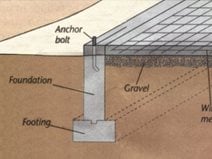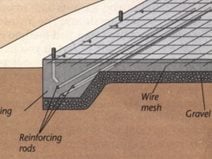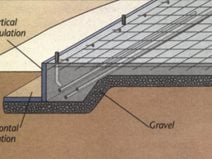- Concrete slabs home
- Use a low water-cement ratio: How to calculate
- Subgrades and subbases for concrete slabs: Tips for ensuring good support
- Concrete Slab Finishing Tips
- DIY Slab Mistakes to Avoid
- How to Prevent Cracks
- Guidelines for preventing cracks in concrete slabs
- Be active in deciding where control joints will be placed
- Reinforcing Concrete Slabs
- Proper Curing of Concrete Slabs
- Properly curing concrete slabs: Why and how
- Related Information:
- Concrete fasteners
- Concrete forms
- The three types of concrete foundations
- Aggregates in ready-mix concrete
- Vapor barriers for concrete slabs
- Post-tensioned concrete slabs
- Concrete slabjacking
- Concrete testing
Three Types of Concrete Foundations
There are many variations of concrete slabs depending on the purpose of the slab. Below are some useful links for understanding concrete foundations, along with the three types of concrete foundations.
Find Foundation Contractors Near Me
The Foundation Construction Process

T-Shaped
T-Shaped
A traditional foundation method to support a structure in an area where the ground freezes. A footing is placed below the frost line and then the walls are added on top. The footing is wider than the wall, providing extra support at the base of the foundation. A T-shaped foundation is placed and allowed to cure; second, the walls are constructed; and finally, the slab is poured between the walls.
In summary:
- T-shaped foundations are used in areas where the ground freezes.
- First, the footing is placed.
- Second, the walls are constructed and poured.
- Lastly, the slab is placed.

Slab-on-grade foundation
Slab-on-grade foundation
As the name suggests, a slab is a single layer of concrete, several inches thick. The slab is poured thicker at the edges, to form an integral footing; reinforcing rods strengthen the thickened edge. The slab normally rests on a bed of crushed gravel to improve drainage. Casting a wire mesh in the concrete reduces the chance of cracking. A slab on grade is suitable in areas where the ground doesn't freeze, but it can also be adapted with insulation to prevent it from being affected by the frost heaves. (see below)
In summary:
- Slab on grade used in areas where ground does not freeze.
- The edges of the slab-on-grade are thicker than the interior of the slab.
- The slab-on-grade is monolithic (poured all at one time).

Frost Protected
Frost Protected
This method only works with a heated structure. It relies on the use of two sheets of rigid, polystyrene insulation-one on the outside of the foundation wall and the other laid flat on a bed of gravel at the base of the wall-to prevent freezing, which is a problem with slab-on grade foundations in areas with frost. The insulation holds heat from the structure in the ground under the footings and prevents heat loss from the edge of the slab. This heat keeps the ground temperature around the footings above freezing.
In summary:
- Only works with a heated structure.
- Has the benefits of a the slab-on-grade method (concrete poured monolithically) in areas subject to frost.
- Concrete is poured in one operation, versus 3 pours required for T-shaped foundations.
Return to Building High Quality Slabs on Grade
All information about footings is from Sunset Books "Sheds and Garages".
 Brickform Ultra-M1x
Add color and fiber with one product
Brickform Ultra-M1x
Add color and fiber with one product
 Rescue-Pak
Contains six of the most effective admixtures
Rescue-Pak
Contains six of the most effective admixtures
 UltraFiber 500®
Will not ball or fuzz, accepts color
UltraFiber 500®
Will not ball or fuzz, accepts color




